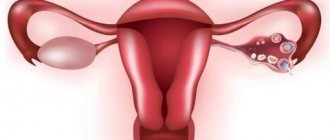While some women dream of carrying and giving birth to a child, others are looking for ways to terminate an unwanted pregnancy. Modern medicine and pharmacology provide a huge selection of contraceptives that can prevent conception, but despite this, the number of abortions performed by doctors is constantly growing. According to statistics, about 20 thousand women a year get rid of an unwanted pregnancy. It is difficult to give this act an unambiguous moral assessment, however, from a scientific point of view, an embryo is the first stage of development of the human body and is fully equated to a newborn child, and abortion is murder. Morality does not force a woman to forcibly follow her own interests, but demands that she take responsibility for her actions without paying with the life of an unborn person. On the other hand, such a serious medical intervention as abortion always has an extremely detrimental effect on the woman’s body, especially on the organs of the reproductive system. The consequences can be extremely dire, ranging from hormonal imbalance and the development of various neoplasms, ending with infertility. Therefore, if a woman has doubts about carrying out this procedure, first of all, it is necessary to consult a gynecologist who will tell you about all the possible risks. There are certain periods at which the procedure can be carried out by medical professionals, and various types of abortions are offered; let’s look at them in more detail.
Until what time can you have an abortion?
Abortion is the artificial termination of pregnancy before 22 weeks. This is a medical procedure that is not aimed at treatment, but at stopping the vital activity of a living organism. If we look at pregnancy week by week, it is divided into two stages: embryonic (up to 8 weeks) and fetal (from 9 weeks until birth). In the first case, the embryo is called an embryo, and in the second, a fetus in which internal organs and systems are actively forming. Starting from 5 weeks, the heart is formed, the contraction of which can be heard during an ultrasound examination. Despite this, abortion can be performed up to 12 weeks and no later than 22 weeks.
According to the regulations of domestic legislation, abortion up to 12 weeks is considered early, and can be carried out if desired by any woman. After 12 and up to 22 weeks, the procedure is allowed to be performed only for social or medical reasons, including:
- rape of a woman;
- fetal death;
- ectopic pregnancy;
- severe pathologies of the fetus that are incompatible with life;
- maternal illnesses that will not allow you to bear and give birth to a healthy child;
- the need for another medical procedure or surgery that is incompatible with pregnancy.
Before a late-term abortion is performed, a meeting of a medical commission is held, which decides to terminate the pregnancy, eliminating risks and possible complications. It is important to understand that having an abortion early or late can have irreversible consequences for a woman’s health and the doctor must be informed about them.
Risk factors
The risk of spontaneous abortion increases significantly under the following conditions:
- delayed maternal sexual development (infantilism);
- previous induced abortions, especially during the first pregnancy;
- dysfunction of the endocrine glands: thyroid, adrenal glands, pituitary gland, ovaries;
- acute and chronic infectious diseases and intoxications;
- isthmic-cervical insufficiency;
- intrauterine adhesions (synechia);
- immunological incompatibility of the blood of mother and fetus according to the Rh factor;
- tumors of the genital organs, etc.
Physical factors - bruises, heavy lifting - are important only for predisposing reasons.
Abortion methods
To receive a referral for an abortion, a woman must undergo a series of medical tests, including:
- a blood and urine test for hCG levels will help exclude ectopic pregnancy;
- Ultrasound of the pelvic organs;
- blood for STDs: syphilis, HIV, hepatitis B and C;
- vaginal smear;
- general blood and urine analysis.
The results obtained allow us to obtain an accurate picture of pregnancy, identify concomitant diseases, and determine possible disorders in the development of the fetus.
In medical practice, there are different methods of abortion that are used in a particular case. In addition to third-party intervention, termination can occur independently - a miscarriage, which is the result of an unsuccessful pregnancy or the impact of certain factors on the fetus or the woman’s body.
In other cases, we will talk about medical abortion, which can be carried out in several ways. Abortion happens:
- medicinal - consists of taking certain hormonal drugs that are taken according to a strict regimen;
- mini-abortion - using a vacuum aspirator;
- instrumental - curettage of the uterine cavity with vacuum aspiration of the fertilized egg;
- minor caesarean section.
Another method of abortion is saline, which consists of introducing a saline solution into the fetal bladder, it kills the fetus. After 2 days, hormonal drugs are prescribed to induce labor. In practice, this type of abortion is not encouraged, since there have been cases when during childbirth, the fetus was alive, but had severe abnormalities.
There are different methods of abortion, but the choice of the method used is up to the doctor and the woman, depending on the duration of pregnancy and the general health of the woman. The shorter the period, the lower the risks. And do not forget that starting from the 8th week, the fetus develops a nervous system, heartbeats are clearly audible, and by the 16th week it already hears sounds and can react to them. Therefore, if pregnancy is unwanted or there are medical indications for its termination, there is no need to waste time.
Medical abortion
Medical termination of pregnancy is recommended before 7 weeks of pregnancy. It consists of taking certain medications that are prescribed by the doctor individually for each patient. These medications contain substances that block the functioning of the hormones progestin and prostaglandin, the deficiency of which causes termination of pregnancy. In practice, Mifepristone tablets are most often used, then Misoprostol. The former lead to the death of the embryo, and the latter cause contraction of the uterus and remove the dead embryo from its cavity. These drugs are dispensed according to a strict doctor's prescription, as they have many contraindications and side effects. The dosage is determined by the doctor. After an abortion, 7 days later, a woman must undergo an ultrasound of her pelvic organs.
Women believe that medical abortion is one of the safest and does not require mechanical or surgical intervention, but this is far from the case. This procedure has a number of contraindications:
- ectopic pregnancy;
- more than 49 days since the last menstruation;
- bronchial asthma;
- pathologies of the adrenal glands;
- renal failure;
- diseases of the genitourinary system.
The danger is that after a medical abortion there is a high risk of developing uterine bleeding, as well as excessive contraction of the uterus, vomiting, nausea, heart rhythm disturbances and other complications. If there is a high risk of complications, taking medications to terminate a pregnancy should be carried out under the supervision of a doctor in a hospital setting.
Vacuum abortion
Mini-abortion (vacuum abortion) is a procedure to terminate an unwanted pregnancy; it is a gentle operation because it does not involve surgical intervention. It lasts up to 12 weeks and consists of vacuum suction of the embryo from the uterus using an aspiration catheter. The procedure eliminates damage to the mucous membranes and does not cause isthmic-cervical insufficiency or cervical injury. If the woman has not given birth before, it is performed using anesthesia. It takes no more than 1 hour. 7 days after the procedure, an ultrasound is prescribed, which will help rule out incomplete removal of the fertilized egg.
Vacuum abortion is contraindicated if:
- ectopic pregnancy;
- period is more than 12 weeks;
poor blood clotting;
- inflammation of the pelvic organs.
After the procedure, a woman may experience pain in the lower abdomen, menstrual irregularities, or hormonal imbalance. A mini-abortion prohibits reconception earlier than after 6 months, so the doctor prescribes hormonal contraceptives to the woman, which will prevent reconception.
Surgical abortion
Surgical abortion allows you to terminate a pregnancy up to 22 weeks. During the procedure, the contents of the uterus are physically scraped out along with the fertilized egg, which prevents further development of the embryo. Despite the 100% result, this type of abortion is performed in cases where other methods are ineffective.
During an abortion, the cervix is opened with special instruments, a curette is used to scrape out the fetus, and forceps may be used. If it is not possible to completely remove the embryo, it is removed in parts. Instrumental abortion is the most reliable, but also the most dangerous. It is performed under general anesthesia in a hospital setting.
Thanks to the capabilities of modern surgery, a hysteroscope can be used during the operation, which is inserted into the uterine cavity, eliminating the risk of damage to the endometrium, and guarantees that after the operation no unremoved fragments of the embryo will remain in the uterus.
The operation takes from 20 to 30 minutes, but after it is performed, the woman must spend several hours in the hospital under medical supervision. Normally, there should be no heavy bleeding, nausea, vomiting or severe pain in the lower abdomen.
Surgical abortion has some contraindications, including:
- poor blood clotting;
- pelvic organ infections;
- inflammatory processes.
After an instrumental termination of pregnancy, the risk of complications is quite high, and may be associated with a medical error or the internal health state of the woman herself. Common consequences include:
- menstrual irregularities;
- adhesions;
- obstruction of the fallopian tubes;
- hormonal imbalance;
- benign tumors;
- infertility;
- depressive states.
Complications after surgical termination of pregnancy may appear immediately after the abortion procedure or after a certain period of time. Therefore, doctors recommend that after surgery you pay close attention to your health, and at the first ailments, turn to specialists for help.
Which abortion is the safest?
There are no safe types of abortion, since any method has its contraindications and side effects. But if there is a need for it, it is better to terminate the pregnancy before 7 weeks. The longer the pregnancy, the higher the risks of complications and adverse effects on the body.
In the early stages, preference is given to medical or vacuum abortion, and in later stages, surgery. Regardless of the chosen technique, a woman after the procedure should follow a number of rules that will help the body recover faster and reduce the risk of complications:
- taking antibiotics to reduce the risk of inflammation;
- taking oral contraceptives to normalize hormonal levels;
- proper and healthy nutrition;
- In the first days after an abortion, avoid physical and mental stress.
If after an abortion there is severe pain in the lower abdomen, bleeding, vomiting, nausea, you should immediately seek medical help, do not self-medicate or wait until you feel better.
Consequences of abortion
Any type of abortion is stressful for the body, which is already preparing to bear a fetus, so there are consequences of such a procedure, and they do not always go unnoticed for the woman. Common complications include:
- uterine bleeding;
- secondary infection;
- mechanical damage to the uterine wall;
- high risk of developing endometritis;
- infertility;
- systematic pain in the lower abdomen;
- menstrual irregularities;
- the need to remove the uterus if it is severely damaged;
- hormonal imbalance.
Women believe that the most dangerous complication of abortion is infertility, but this is not entirely true, since other diseases are no less dangerous. A large percentage of women are unable to bear a child, and even if they are pregnant, they face constant spontaneous miscarriages.
Signs of an incipient miscarriage
In the initial stage of spontaneous abortion, aching, sometimes cramping pain in the lower abdomen or lumbar region is observed. When the placenta separates from the wall of the uterus, bloody discharge appears from the genital tract. As the detachment process progresses, the bleeding intensifies. Often, heavy bleeding may occur, leading to severe anemia. Together with the blood, the fertilized egg comes out of the uterus. After this, the uterus begins to contract and the bleeding stops. If parts of the membranes and placenta remain in the uterus, it will not contract and bleeding will continue. Heavy uterine discharge can become life-threatening. The cervix remains slightly open, which favors the development of inflammatory diseases due to the entry of pathogenic microorganisms there.
Sometimes the elements of the fertilized egg retained in the uterus are very small, and bleeding may stop, but subsequently polyps are formed from these elements, preventing the healing of the surface of the uterus. They can lead to prolonged bleeding from the genital tract.
Determining whether the fetus is developing in the womb or not can be determined by determining the level of human chorionic gonadotropin (hCG) over time. An increase in the amount of this hormone in two days indicates a normal pregnancy. If the level of human chorionic gonadotropin remains the same or decreases, it means that the development of the fetus has stopped.








